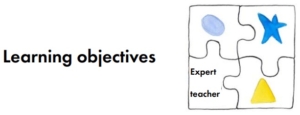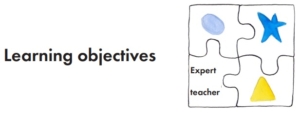2.1 Establishing Educational Goals
On this page
- Importance of establishing educational goals
1.1 Establishing educational goals
1.2 Focus on establishing qualification
1.3 Starting with establishing educational goals - Goals Friendly and Fair Teaching
2.1 Practical additions to goalsFFT
2.2 Learning goals
2.3 Origin goals FFT - Teacher goals per lesson
- Target domains Gert Biesta
4.1 Formulation three domains by Biesta
4.2 Adjusted formulation three domains by FFT
4.3 Broad application domains
4.4 Getting started with the target domains - Psychological basic needs Ryan & Deci
- Balance
- Summary
- Credits
Friendly and Fair Teaching offers teachers a structure to make their lessons run smoothly. In addition, each teacher determines learning objectives per lesson. FFT advises teachers to include the target domains of Biesta and the Psychological Basic Needs of Ryan & Deci when determining learning objectives.
I structure my lessons by alternating ‘Teacher-Centred Education’ with Student-Centred Education. With this alternation, I make my lessons varied and challenging. I determine learning objectives per lesson and am inspired by the target domains of Biesta and the Psychological Basic Needs of Ryan & Deci.

Haim Ginott
This quote illustrates the critical role of a teacher in providing a positive learning environment. Ginott’s reflective thinking underlines the importance of emotional intelligence, which is as important, if not more important, than a teacher’s IQ. The recipe for successful teaching can therefore be seen as EIQ + IQ + ???. We invite you, the teacher, lecturer or teacher in training, to formulate your own educational goals that contribute to successful teaching.” Mick O’Mahony
Introduction video
For more information check out our other introductory videos here.
Current approach:
What goals am I pursuing with my teaching now?
Future approach
What goals am I pursuing with my teaching in the future?
Introduction
‘Establishing educational goals’ is one of the three modules of the perspective ‘Establishing fairness‘ of Friendly and Fair Teaching (FFT).
Figure 27: Establishing fairness (overview)
You use this module ‘Educational Objectives’ to create a positive learning environment.
On the one hand, you transfer knowledge and inspire your students (Teacher-Centred Education). You do this in an expressive way. On the other hand, you coach and observe your students (Student-Centred Education). As a coach, you watch, listen and give helpful suggestions. If you see that a student has talent in a certain area, you give individual recommendations that help this student to develop further. By alternating between ‘Teacher-Centred Education’ and ‘Student-Centred Education’, you make your lessons varied and challenging.
1. Importance of establishing educational goals
1.1 Establishing educational goals
In the overview of FFT you see three abstract forms. These forms represent both the creation of a positive learning environment with the structure that FFT offers for this and the learning objectives that you fill in yourself per lesson.

Figure: Learning objectives
1.2 Focus on establishing qualification
If you see Qualification or Competence as the only educational objective, there is a chance that you limit your education to mainly uniform assignments that result in a joint, central, individual test. The incentive for students is then to get a high grade. With high grades you reward students, with low grades you encourage students to make more of an effort.
The question is whether you offer students the opportunity to develop sufficiently on a social and personal level with this way of giving grades. Moreover, there is a chance that students who are not able to get high grades, or who do not succeed in getting a sufficient grade, will drop out. See pitfall ‘Student-centred education’.
1.3 Starting with establishing educational goals
Start by alternating between ‘Teacher-Centred Education’ and ‘Student-Centred Education’ (Chunking). Especially with ‘Student-Centred Education’ you offer your students the opportunity to develop in the areas of ‘Personal development’ and ‘Autonomy’. Determine the learning goals you want to achieve per lesson.
2. Goals Friendly and Fair Teaching
How do you create a positive learning environment? You can use this ‘coat rack’ to structure your lessons.

Image: Alternating teaching the entire class and working independently (overview)
Light blue dot: CHUNKING. You alternate between ‘Teacher-Centred Education’ and ‘Student-Centred Education’. With this alternation, you make your lessons varied and challenging. Watch this video that shows why this alternation is important.
Thunder blue star: KNOWLEDGE – INSPIRE’. With ‘Teacher-Centred Education’ you transfer knowledge and inspire your students in an expressive way.

Figure: Genie out of the bottle (overview)
Yellow triangle: COACHING – OBSERVING. During ‘Student-Centred Education’ you coach your students. You listen, give helpful suggestions, and distract students as little as possible. You give your students confidence and strengthen their autonomy. In this way, they develop into unique individuals.

Figure: Genie in the bottle (overview)
If you see that a student has talent in a certain area, you give an individual recommendation that helps this student to develop further. You can think of helping other students, taking on a responsibility for the school such as helping to put together a school newspaper, taking a seat on the participation council, participating in performances or giving a presentation. Such an invitation can be decisive for the development of a student. This will broaden and deepen your learning objectives.

Figure: Detective in search of talent (overview)
2.1 Practical additions to VOH objectives
During ‘Working Independently’ you base one or more test grades on the number of successfully completed tasks within a planned period (Check marks – Grades based on amount of completed assignments). This way of assessing increases the motivation of students.
When students are ‘Working Independently’ you limit the freedom of students in two ways:
- You ask your students to adhere to the ‘Framework’ and the instructions of the ‘Triangle’. If necessary, you address a student on behaviour or commitment.
- You ask your students to deal responsibly with the freedom you offer. In this context, read the book by Gert Biesta: ‘The beautiful risk of education‘.
- You gain the trust of your students by being friendly and fair and by not adopting a dominant attitude.
2.2 Learning objectives
Within your positive learning environment, you determine your own learning objectives. Be inspired by the target domains of Biesta and Psychological basic needs of Ryan & Deci. If successful, your students will continue to develop after school (combination of formal and informal learning).
2.3 Origin of FFT objectives
The objectives of FFT are a practical elaboration of the credo of the Rapucation Foundation:

Image 107: Credo Rapucation Foundation (overview)
3. Teacher goals per lesson
For each lesson, you determine which goals you are going to work on.

Figure: Learning goals (overview)
Use the FFT goals as a framework for your lessons
Consult when formulating your goals:
- Biesta: Target domains
- Ryan & Deci: Psychological basic needs
4. Target Domains Gert Biesta
How do you give every student the opportunity to develop in multiple areas? Gert Biesta defines three domains for education. Friendly and Fair Teaching has slightly modified the formulation of these domains with the knowledge of Gert Biesta. Compare the original formulation with the modified formulation:
4.1 Formulation of three domains by Biesta
Original formulation (Biesta 2013):
Qualification – This has to do with transmission and acquisition of knowledge, skills and attitudes that qualify children and young people to do “something,” both for a profession and for life in a complex modern society.
Socialization – This has to do with how education introduces and connects children to existing traditions and practices – both socio-cultural, political, religious and philosophical practice, as well as vocational and professional practices.
Subjectivation – This can include qualities such as independence, responsibility and also maturity.
4.2 Redefined domains by FFT
The following are Gert Biesta’s three domains that were redefined by FFT in March 2021. In the current formulation, the objectives can be used across the school. Whether you are a student, teacher, school leader or have a supporting role at school, the objectives apply to everyone. See broad application of domains
Qualification – This has to do with transfer and acquisition of knowledge, skills and attitudes that qualify one to do “something,” both for a profession and for life in a complex modern society.
FFT links Qualification to the module ‘Assessment’.
Socialization – This has to do with introduction into and connection with existing traditions and practices – socio-cultural, political, religious and philosophical practice, as well as vocational and professional practices.
FFT pays attention to Socialization in the module ‘Getting to know each other’
Subjectivation – This can include qualities such as independence, responsibility and also maturity.
FFT links personal development to the module ‘Student-centred education’.
On this site, we consistently write the three target domains of Biesta with a capital letter to indicate that Friendly and Fair Teaching gives each domain an adapted formulation. In this new formulation, the objectives are intended for everyone, including you as a teacher.
4.3 Broad application of domains
By omitting ‘education’ in the new formulation, the domains also gain general validity outside of education for everyone who is new somewhere. With the new formulation, everyone gets the chance to constantly continue to acquire new knowledge. This happens on a voluntary basis and from their own motivation.
4.4 Application domains in FFT
By applying Biesta’s three target domains, you broaden your offering, make your lessons interesting for your students and they can concentrate well:
Qualification ensures that your students have the necessary knowledge and skills.
Socialization ensures that your students can work well together and take responsibility at school and hopefully also outside of school.
Subjectivation means discovering who you are as a student in freedom (through trial and error). Subjectivaion cannot be forced. See ‘The beautiful risk of education’ by Biesta.
Gert Biesta compares the conversion of target domains into learning objectives and lessons with playing chess on three boards at the same time. Why is that necessary?
If you focus entirely on Qualification and central testing, the result is more or less qualified students who adopt your subject knowledge. If you focus on Socialization and Subjectivation in addition to qualification, you prepare your students for their role in society and your way of teaching will help your students emerge as unique adults.
A quote that ties in with focusing entirely on Qualification:
What amazes me most about Western man is that he sacrifices his health to earn a lot of money. Then he sacrifices the money again to restore his health. And then he is so worried about the future that he does not enjoy the present, with the result that he does not live in the present, but also not in the future. He lives as if he will never die and dies while he has never lived.” Dailai Lama
5. Psychological basic needs Ryan & Deci
Ryan & Deci formulated the ‘Psychological basic needs’:
Autonomy
This is the urge to see connections between one’s own actions and those of others in the environment. Deci and Ryan discovered that extrinsic rewards for intrinsically motivated behaviour undermine intrinsic motivation. As a result, autonomy decreases. It is better to also reward intrinsic behaviour intrinsically, which gives an individual the idea that he/she has more control over his/her life.
FFT links the psychological need ‘Autonomy’ with ‘Student-Centred Education’.
The teacher prepares an environment in which students choose their own path during ‘Working Independently’. They see other students make (attractive) choices and can follow the example of another student in a subsequent period.
The teacher increases intrinsic motivation by asking students to evaluate a self-chosen topic before presenting it to the teacher.
Competence
This concerns the urge to control the outcome, as well as the control of one’s own experiences. Deci and Ryan discovered that giving unexpected positive feedback increases people’s intrinsic motivation and competence.
FFT links the psychological need ‘Competence’ to ‘Assessment’.
Connectedness (Relationship)
This is about the urge for connectedness with the environment and other individuals. It is also called ‘psychological connectedness’. Humans are social animals and need to interact and communicate with others. Ryan & Deci mainly mean the relationship between teacher and student by connectedness.
FFT’s comments on Connectedness:
- FFT believes that this connection is truly successful if it translates into a good relationship between teacher and student and into a good understanding and cooperation between students.
- The ‘Framework’ (Friendly + Fair) requires everyone to treat each other well. In this way, the teacher ensures that the connection is established in a good way (you can also connect with someone in a bad way).
- FFT links the psychological need Connection (Relationship) with ‘Building Relationships’.
6. Balance
Education can be seen as a search for the right balance.
A clearly agreed ‘Framework’: Friendly and Fair + clear instructions with the ‘Triangle’ provide the impetus for an inclusive, peaceful environment that excludes no one, where all attention goes to the lesson and where everyone flourishes.
The alternation between ‘Whole Class Teaching’ (Teacher-Centred Education – informing) and ‘Working Independently’ (Student-Centred Education – experiencing), inspires your students and gives them autonomy. Because everything runs in a good atmosphere, more and more trust is created.
By paying attention to Subjectivation in addition to Qualification, you make students assertive and you will have to deal with contradiction. Take that into account and learn to deal with it. By moving along with the wishes of your students, you help them get where they want to be.
When searching for the right balance, you take into account the ‘Psychological basic needs’ of every person.
Achieving the right balance between the three domains is, in and outside of education, a lifelong quest. One-sided attention to Qualification and testing is at the expense of Socialization and Personal Development.” Biesta 2012
7. Summary
Friendly and Fair Teaching advocates preparing students for their role in society in a peaceful, inclusive way:
- You use the practical instructions of FFT to create a positive learning environment.
- In your lesson preparation, you include the three target domains: Qualification, Socialization and Personal Development (Biesta)
- You take into account the psychological basic needs of your students (Ryan & Deci).
By taking educational goals as a starting point, you make your lessons engaging.
8. Credits
Gert Biesta
Gert Biesta names target domains that are central to education: Qualification, Socialization and Subjectivation. For teachers it is a challenge to offer these target domains in the right balance in the teaching practice.
Partly thanks to a remark by Gert Biesta, FFT now compares education with a coin with two sides that are inextricably linked: ‘Teacher-Centred Education’ + ‘Student-Centred Education’.




